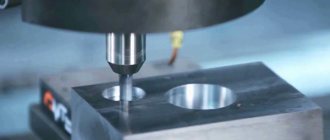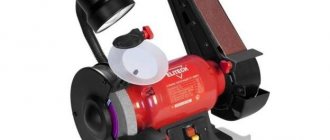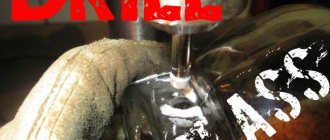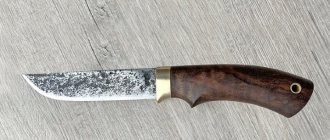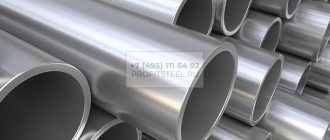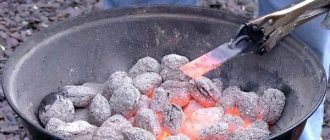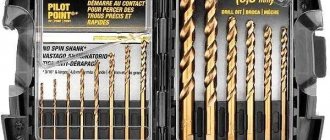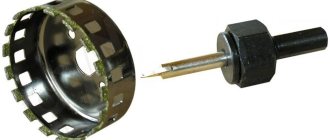It is not difficult to drill ordinary steel or any other metal; standard drills made of high-speed material are used for this. Drilling through hardened steel is another matter: it requires some work. After hardening, the workpiece acquires extraordinary strength, and the question arises of how to drill a hole in hardened metal, because in this case an ordinary drill can no longer help much.
Experts recommend making holes in the parts before hardening occurs. You can also try tempering the steel, then drill and harden the material again. If this is economically justifiable and technically feasible, then this should be done, but in some cases it is simply impossible to do otherwise than proceed to obtain a channel on an already hardened surface.
There are several methods that allow you to drill holes of any diameter in hardened metal. These methods can be implemented with great success both in production and in the home workshop.
Methods for drilling holes in hardened metal
How to drill a hole in hardened metal using acid, a welding machine, special drills and what additional tools are needed for this. Which drills work best with hardened steel?
It is not difficult to drill ordinary steel or any other metal; standard drills made of high-speed material are used for this. Drilling through hardened steel is another matter: it requires some work. After hardening, the workpiece acquires extraordinary strength, and the question arises of how to drill a hole in hardened metal, because in this case an ordinary drill can no longer help much.
Experts recommend making holes in the parts before hardening occurs. You can also try tempering the steel, then drill and harden the material again. If this is economically justifiable and technically feasible, then this should be done, but in some cases it is simply impossible to do otherwise than proceed to obtain a channel on an already hardened surface.
There are several methods that allow you to drill holes of any diameter in hardened metal. These methods can be implemented with great success both in production and in the home workshop.
What is the problem
Understanding how to drill a hole in hardened metal requires a little explanation.
Hardening is a special type of metal processing in which it heats up greatly and then cools sharply. After the procedure, hardened steel becomes harder and stronger, resistance to fracture decreases, and resistance to abrasion increases. At the same time, the material becomes more brittle, less flexible and ductile.
Drilling into plain steel is not difficult. To do this, use standard drills made of high-speed material. Tempered steel is much stronger; a regular drill will not take it - it will quickly become dull and become unusable.
If possible, it is better to drill the necessary holes before hardening the steel. If this is not possible, you need to prepare a suitable tool. Commercial drill bits for drilling hardened steel are usually suitable, but in rare cases special equipment may be required.
Methods for drilling hardened steel
Drilling hardened steel is characterized by high heating of the surface of the workpiece and tool, which leads to rapid wear of the latter. Therefore, during processing, they try to remove excess heat or make the area where the channel will be softer.
The first method, which allows you to make hot metal more pliable, is based on the use of acids. Suitable substances may include nitric, perchloric or sulfuric acid. These liquids are used pointwise, that is, they are used to treat specifically the place where there will be a hole in the future (the area is etched). To prevent the acid from leaving the working area from materials not exposed to acid (polymers, paints, paraffin), something like a side is organized around the future hole. The hole is filled with active liquid and left for a certain time. Next, drill with a regular drill.
The easiest way, but not the cheapest, is to purchase a special drill designed for making holes in hardened metal. The cutting edges of such a tool are reinforced with pobedit tips or made of pobedit plates. In this case, it is also desirable to use additional cooling of the work area.
When working with acids, you need to be extremely careful and perform the operation in a well-ventilated area. This will help prevent burns or poisoning from harmful fumes.
Which drill to drill hardened steel
Drilling ordinary steel does not cause problems. Almost any drill made of high-speed material is suitable for this. But difficulties often arise with drilling hardened metals. And here it is important to choose the right processing tool.
Maximum strength
After the hardening process, the steel acquires extraordinary strength. That is why high-speed drills can no longer cope with processing such material. So the choice of a tool made from hard alloys is obvious. The cutting edge of such metal drills is noticeably stronger.
However, as we already wrote in our blog, a carbide drill does not like increased vibrations. Excessive shaking even on such a durable instrument causes chips and cracks. Therefore, it is important to monitor the rigidity of the machine, the quality of the clamping equipment, and the reliability of fastening the workpiece.
Fighting overheating
Drill strength is not the only issue that arises when machining hardened steels. This process is always accompanied by strong heating of the cutting site, as well as the processing tool, which leads to rapid wear of the latter.
Due to sharp temperature fluctuations during drilling, microcracks appear on the cutting edges of carbide tools. And after a while the drill may break completely. This is why the number one goal when drilling hardened steels is to keep the temperature in the cutting area as low as possible.
In this, of course, first of all, a drill made of hard alloys helps. The material is very resistant to high temperature loads, which extends the service life of the tool.
Secondly, a carbide drill for hardened steel must have a special hardening coating. We wrote more about the types of coatings in this article.
The most popular coating used in drills to strengthen and increase heat resistance is a coating of titanium aluminum nitride - AlTiN. It is ideal for dry, high-speed machining of materials with low thermal conductivity, including hardened steels.
This coating is applied using the PVD (physical vapor deposition) method in a very thin layer - the thickness does not exceed 5 microns. This makes it possible to keep the cutting edge as sharp as possible, which is especially important during finishing and processing with increased precision requirements and tight dimensional tolerances.
The AlTiN coating acts as a barrier between the cutting edge and the cutting zone, so the heat generated during drilling does not penetrate deep into the drill, but is dissipated into the resulting chips.
Is coolant needed?
Needed. As a rule, eliminating chips from a hole is not a problem when drilling hardened steels, since they are quite small and can be easily removed through the chip escapement. But to prevent it from getting stuck in front of the drill, it is still recommended to use a cutting fluid, supplying it under high pressure.
Alternative drill
If you are going to drill holes whose diameter exceeds 15 mm, we recommend that you pay attention to a body-mounted tool with replaceable carbide inserts. It will be much more cost effective. And the strength of a core drill is much higher than that of a solid one. You can read more about cabinet drills in our blog.
You can find out prices and current information on the availability of drills from the world's best manufacturers in our catalog or from the managers of the TIGROTECH company by phone +7 (495) 642-31-30
or at
[email protected]
Application of lubricants
- The drilling area on hardened metal is marked with a core. Apply a small amount of lubricant to this point. If it is liquid, then squeeze out a drop of oil so that it does not spread.
- The cutting area of the tool is dipped into the lubricant and placed at the previously marked point.
- When drilling hardened metal, monitor the amount of lubricant and add it as it is used up.
- Monitor the heating status of the instrument, preventing it from overheating. Intensive smoke emission from burning lubricant indicates the need to stop work and cool the equipment and metal.
Brands of drills for hardened steel
Steel grade R6M5K5 is a domestically produced material, where there is less tungsten, only 6%, but its deficiency is compensated by the use of the cobalt element in the alloy (up to 5%). Cobalt also contributes to the strength of the equipment and the ability to withstand increased thermal loads for a long time when working with hardened materials.
Among foreign analogues of high-speed steels suitable for the production of drills for hardened metal, it is worth noting the HSS-Co brand. This is, in fact, the same tool as the previous one, where there is a similar composition of the main alloy elements.
Any drills for porcelain stoneware are also suitable for making holes in hardened metal, only their pobedite tips need to be sharpened.
Marking and color of metal drills
Those owners who have had to do drilling at least once, I think, tried to understand what material is used to make these devices, what is meant by the marking on the tool?
What makes it possible to create holes on a surface made of the same material from which the drill itself is made? The efficiency of working with a drill is achieved due to the fact that high-quality and high-strength steel is used as the material for it. But cheap options that are produced on a raw material basis are not able to cope with most of the problems that many owners face.
What does the drill marking mean?
Typically, the marking of a metal drill contains a certain set of letters and numbers . The letter of the main element is usually indicated first, followed by a number that corresponds to the percentage of this element in the material used to produce the drill.
After the first two characters, other elements are often specified.
- P – corresponds to tungsten;
- K - indicates cobalt;
- F - means vanadium;
- M – means molybdenum.
Most often, the labeling does not include the designation of chromium, since this element is necessarily included in the source material, in which its share is about 4%. Among the elements that are missing from the labeling, carbon should be highlighted. For example, if a drill is marked P7M6K6 , then it can be understood that the manufacturer used high-speed steel as a material, which contains tungsten in the amount of 7%, molybdenum - 6%, cobalt - 6%.
If you pay attention to domestic products, there is no such information. However, this applies primarily to products whose diameter is less than 2 mm. Devices with a diameter of 2-3 mm contain information about the geometry and grade of steel. Drills that represent other standard sizes have additional data: they also provide the trademark and sometimes the accuracy class of the drilling product.
What does the drill color mean?
Each of the offered drills can be designed in one of the following colors:
- bright gold;
- black golden;
- grey;
- black.
By the golden color, you can understand that the manufacturer used titanium nitride in the manufacture of the instrument. This operation provides such a drill with increased strength characteristics. Working with such a device will ensure less friction between surfaces.
A black golden hue indicates that the raw material contains a temper, the purpose of which is to eliminate internal stress.
The gray color indicates that the drill in question has not been finished in order to increase the level of protection and strength of the material. From this we can conclude that this device has a low level of workmanship, and therefore it will fail quite soon .
The black color suggests that during the manufacture of the drill, an operation was carried out that involved exposing the product to superheated steam. The benefit of it is to increase its wear resistance.
Homemade drill
It is not necessary to buy an expensive drill for the job; in some cases it can be made at home. A cobalt-tungsten alloy rod is best suited for this - it wins. Such a rod is easy to recognize among other pieces of iron: it will not be cut with a metal blade. Then do the following:
- Place a diamond wheel on the emery.
- They trim one side of the rod and grind off slots on this side, like on a flat-head screwdriver.
- Next, grind down the sides to create a sharp cone.
Dear site visitors, please share in the comments your suggestions on how else you can drill a hole in steel that has been hardened.
Source
How to drill hardened steel at home
To improve the basic characteristics of the metal, it is often hardened. This technology involves increasing the hardness of the product due to strong heating of the metal and its rapid cooling. In some cases, after heat treatment it is necessary to perform drilling. By increasing this characteristic, drilling hardened metal becomes more difficult. Let's take a closer look at all the features of drilling hardened steel.
Drilling a hole in hardened steel
The widespread question of how to drill through hardened steel can be associated with the fact that when using conventional technology, the tool quickly becomes dull and becomes unusable. That is why you need to pay attention to the features of drilling hardened alloy. Among the features of the technology, we note the following points:
- It is necessary to properly prepare the hardened workpiece.
- In some cases, a special tool is required.
- Coolant is being used.
If necessary, you can make a drill for hardened steel with your own hands, which requires certain equipment and skills. However, in most cases, a purchased version is used, since it will cope better with the task when cutting hardened steel.
Hardened steel drilling process
Nuances when drilling
The technology in question has a fairly large number of features that need to be taken into account. Drilling of hardened metal is carried out taking into account the following points:
- Before carrying out work, pay attention to the hardness of the surface. This parameter is used to select the most suitable drill. Hardness can be determined using a variety of technologies.
- During drilling, a large amount of heat is generated. This is why rapid wear of the cutting edge occurs. In this regard, in many cases, cooling liquid is supplied to the cutting zone.
- When cutting difficult-to-cut material, it is necessary to sharpen the cutting edge from time to time. For this, a conventional sharpening machine or a special tool is used. Only diamond-coated wheels are suitable as an abrasive.
Steel Drilling Tool
There are a variety of methods for cutting hardened steel. Some of them significantly simplify the processing. Only by taking into account all the nuances can the quality of the resulting hole be improved.
Useful drilling techniques
A variety of technologies can be used to work with hardened steel. The most common technologies are characterized by the following features:
- Surface treatment with acid. This technology is characterized by long-term use, since it takes quite a lot of time to reduce the surface hardness. Sulfuric, perchloric or other acid can be used for etching. The procedure involves creating a lip that will contain the substance used in the cutting zone. After prolonged exposure, the metal becomes softer, and it will be possible to drill using the conventional version.
- You can use a welding machine to achieve your goal. When exposed to high temperatures, the metal becomes softer, which greatly simplifies the procedure.
- Most often, a special drill is used. There are versions on sale that can be used for processing hardened steel. In their manufacture, metal with increased resistance to wear and high temperatures is used. However, the complexity of manufacturing and some other points determine that the cost of a special tool is quite high.
In addition, to achieve this goal, a punch is often purchased. It can be used to make a small hole, which will simplify further drilling.
Advantages of cobalt drills for metal
Prices for cobalt metal drills are 4-5 times higher than regular ones.
What makes them so popular among home craftsmen? What merits made them so highly rated? A distinctive feature of cobalt is its high melting point . For this reason, metal drills, created on the basis of high-quality high-speed steel alloyed with cobalt, perfectly withstand high temperatures and demonstrate improved mechanical properties. They are characterized by the ability to cope with significant thermal loads, for which they do not have to resort to additional cooling. Similar properties of these metal drills are primarily manifested in situations where it is necessary to create holes in high-strength alloy and high-viscosity steels.
Among other properties that cobalt metal drills have, we should highlight a fairly large sharpening angle of the tip, which is 135 degrees . Thanks to this design of the tip, it becomes possible to drill on smooth round surfaces.
These drilling devices can also be used to create holes in pipes and welds where high precision requirements are important. An important advantage of such metal drills is that when working with them, the master has to exert less physical pressure on them.
Use of lubricants
When drilling through hardened steel, serious friction occurs. That is why it is recommended to purchase and use various lubricants. Among the features of this processing method, we note the following points:
- First, the drilling area is processed. A small amount of lubricant is applied to the surface where the hole will be located.
- Oil is added to the cutting edge. To process hardened steel, a small amount of the substance is required, but it must be added from time to time, since it scatters when the tool rotates.
- During work, it is recommended to take breaks to cool the cutting surface and the surface being processed.
Lubricating steel with special oil
Special oil not only simplifies drilling, but also increases the service life of the tool used.
This is because oil can reduce the temperature of the cutting edge.
Drilling process
Before you start drilling in hardened steel, there are a few things to consider. They are related to the hardness of the material.
Source grandmetal.pro
Before drilling hot metal at home, it is worth considering the following features:
- During operation, a large amount of heat is generated. It is advisable to supply cooling liquid to the work site.
- A drill, especially an unprofessional one, can quickly become dull. It must be sharpened using a diamond wheel.
Before starting work, you need to check the strength of the fastening on the tool itself, as well as whether the part is firmly fixed. If the part is made of polished or chrome-plated steel, put fabric or leather gaskets on the vice to prevent scratching. It is recommended to wear safety glasses and durable clothing.
You should also follow the following rules:
- First you need to turn on the drill at low speeds, then bring it to the workpiece, otherwise it will quickly become dull.
- You also need to withdraw the drill gradually, reducing the speed, but not stopping it completely.
- You need to drill at low speeds, no more than 1000 rpm. This is easy to check: when rotating, the grooves should be visible. If they merge into one whole, it is better to slow down.
Source behance.net
- Before you drill a hole in hardened metal, you need to check the strength of the metal, especially if the drill does not go deep. For this, files of different strengths are used. If there are no marks left on the surface, you should choose a harder drill or one with a diamond tip, and work at low speeds.
- When drilling deep holes, it is worth placing a small piece of compressed foam on the drill. This will allow you to deepen the drill to the desired level and ensure that the chips are blown away.
- When working with a polished surface, you should put a felt washer on the base of the nozzle to avoid contact between the cartridge and the surface.
- If the drill is too thin and does not fit well in the chuck, its tail must be wrapped with brass wire, adding volume.
The power of the drill is calculated based on the technical characteristics of the device.
Additional preparation
To make the drilling process faster and easier, it is worth preparing the surface if possible. To do this, it needs to be softened.
Source mkada.ru
Before drilling into hardened steel, it can be prepared by:
- Welding machine. It is necessary to heat the drilling site to make the metal softer.
- Punch. It allows you to make a small recess, which will simplify drilling.
- Acid (sulfuric, perchloric or any other). It is necessary to make a border around the drilling site so that the acid does not spoil the entire surface, pour liquid there and leave for several hours.
During operation, strong friction occurs, the nozzles begin to heat up and become deformed. This can be dealt with using a special lubricant, but machine oil will also work. It is used in various moments:
- Before starting work, apply a few drops to the drilling point.
- A little oil is applied to the cutting edge of the drill; it is added during operation as the oil is consumed.
- While working, it is worth taking a break from time to time to allow the tool to cool down.
These precautions will help increase tool life and keep drill bits intact.
You can see in more detail how hardened steel is drilled in the video
Drill selection
Twist drills, which are represented by a vertical rod with two grooves, have become quite widespread. Due to the specific arrangement of the grooves, a cutting edge is formed. Among the features of the choice, we note the following points:
- The pobedite drill bit has become quite widespread. It can be used to work with various hardened alloys. However, a surface with too high hardness cannot be processed with such a tool.
- The choice is also made based on diameter. It is worth considering that it is quite difficult to obtain a large diameter hole. The larger diameter version is much more expensive due to the use of a large amount of material in its manufacture.
- Attention is also paid to the sharpening angle, the purpose of the product and the type of material used in manufacturing. For example, cobalt versions are characterized by higher resistance to high temperatures.
- It is recommended to pay attention to products exclusively from well-known manufacturers. This is due to the fact that Chinese versions are manufactured using low-quality materials. However, such an offer is much cheaper and can be used for short-term or one-time work.
- When choosing a drill, you can be guided by the markings. It can be used to determine which materials were used in production. The diameter of the hole that can be obtained when using the tool is also indicated.
In a specialized store you can find almost everything you need to carry out the work. However, the fairly high cost of the product and some other factors determine that some decide to make a drill themselves from scrap materials. Similar work can be done if you have the required tools.
Tool design features
Drills with carbide inserts are characterized by a number of design features. Let's list the most important ones.
- The working length of the drill is reduced by 20–35% due to the fact that its regrinding is carried out only on a carbide plate. The length of drills of this type, if they are used in conjunction with a jig, can be the same as that of a high-speed tool.
- The increase in the diameter of the drill core towards the shank is within 1.4–1.8 mm for every 100 mm of length, as with drilling tools of other categories.
- The angle of inclination of the helical groove of the tool depends on how deep the hole needs to be made.
- On the transverse edge of the drill, it is necessary to make a point with dimensions of 1.8–3.5 mm, which allows to reduce axial forces and reduce the load on the tool body.
- The tapered shank, with which the drill is fixed in the machine spindle, must be precisely adjusted to the seating part, which will increase the rigidity of the drill fastening and minimize the risk of vibration loads, which can cause chipping of the carbide insert and even its breakage.
- To increase the reliability of using carbide drills for metal, a hole is often made in their inner part to supply coolant. This allows you to reduce the cutting temperature, reduce the intensity of tool wear, and also facilitate the process of removing chips from the processing zone.
Drill device with removable plates
To give the working part of the drill the required hardness (56–62 units on the HRC scale), the tool is subjected to heat treatment, which, as a rule, is performed simultaneously with soldering of carbide plates.
High processing performance, as well as stability of drills in this category are ensured by a number of parameters. This includes the shape of the carbide plate, the geometric parameters of its front surface, as well as the material from which such a plate is made. Currently, the most widely used tools are those with carbide inserts of regular three- and tetrahedral configurations, which allow drilling holes with an almost flat bottom.
Better drilling results can be achieved if you use a tool equipped with profiled carbide inserts.
Drills with such inserts, the cutting part of which is made in the shape of a wave, allow processing using step-by-step cutting technology. The use of the latter not only ensures stabilization of the position of the tool at the moment of its cutting into the material being processed, but also minimizes the risk of its withdrawal during further processing. In addition, a drill with a wave-shaped cutting edge can significantly reduce the cutting forces generated during the drilling process.
Drills with mechanical fastening of replaceable polyhedral inserts (drills with MNP)
The design of drills equipped with removable carbide inserts allows them to be used not only for drilling, but also for such technological operations as boring pre-made holes and chamfering. In such cases, a peripheral carbide insert mounted on the tool is used.
Solid insert drills, which are mechanically attached to the tool, are effectively used for machining inclined and concave surfaces, and machining with such a tool can be carried out without pre-drilling holes. To successfully cope with such a technological task, the feed rate with which the tool cuts into the material being processed must be reduced by 50–70%.

